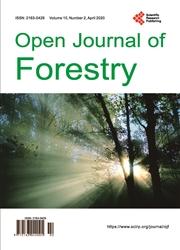Development and Evaluation of Species-Specific Biomass Models for Most Common Timber and Fuelwood Species of Bangladesh
引用次数: 5
Abstract
Allometric biomass models are efficient tools to estimate biomass of trees and forest stands in a non-destructive way. Development of species-specific allometric biomass models requires extensive fieldwork and time. Our study aimed to generate species-specific allometric biomass models for the most common fuelwood and timber species of Bangladesh. We also wanted to evaluate the performances of our models relative to the performances of regional and commonly used pan-tropical biomass models. We used semi-destructive method that incorporates tree-level volume, species-specific biomass expansion factor (BEF), and wood density. We considered four base models, 1) Ln (biomass) = a + bLn (D); 2) Ln (biomass) = a + bLn (H); 3) Ln (Biomass) = a + bLn (D^2H); 4) Ln (Biomass) = a + bLn (D) + cLn (H) to develop species-specific best-fitted models for Total Above-Ground Biomass (TAGB) and stem biomass. The best-fitted model for each species was selected by the lowest value of Akaike Information Criterion (AIC), Residual Standard Error (RSE) and Root Mean Square Error (RMSE). The derived best-fitted models were then evaluated with respect to regional and pan-tropical models using a separate set of observed data. This evaluation was conducted by computing ME (Model Efficiency) and MPE (Model Prediction Error). The best-fitted allometric biomass models have shown higher model efficiency (0.85 to 0.99 at scale 1) and the lowest model prediction error (-8.94% to 5.27%) compared to the regional and pan-tropical models. All the examined regional and pan-tropical biomass models showed different magnitude of ME and MPE. Some models showed higher level (>0.90 at scale 1) of ME compared to the best-fitted specific species biomass model.孟加拉国最常见木材和燃料木物种特定生物量模型的开发和评估
异速生物量模型是以非破坏性的方式估计树木和林分生物量的有效工具。开发物种特异性异速生物量模型需要大量的实地调查和时间。我们的研究旨在为孟加拉国最常见的薪材和木材物种生成物种特异性异速生物量模型。我们还想评估我们的模型相对于区域和常用的泛热带生物量模型的性能。我们使用了半破坏性方法,包括树木水平的体积、物种特异性生物量膨胀因子(BEF)和木材密度。我们考虑了四个基本模型,1)Ln(生物量)=a+bLn(D);2) Ln(生物量)=a+bLn(H);3) Ln(生物量)=a+bLn(D^2H);4) Ln(生物量)=a+bLn(D)+cLn(H),以开发总地上生物量(TAGB)和茎生物量的物种特异性最佳拟合模型。通过Akaike信息准则(AIC)、残差标准误差(RSE)和均方根误差(RMSE)的最低值来选择每个物种的最佳拟合模型。然后,使用一组单独的观测数据,就区域和泛热带模型对导出的最佳拟合模型进行评估。该评估是通过计算ME(模型效率)和MPE(模型预测误差)来进行的。与区域和泛热带模型相比,拟合最好的异速生物量模型显示出更高的模型效率(在1级时为0.85至0.99)和最低的模型预测误差(-8.94%至5.27%)。所有研究的区域和泛热带生物量模型都显示出不同程度的ME和MPE。与最拟合的特定物种生物量模型相比,一些模型显示出更高的ME水平(在尺度1上>0.90)。
本文章由计算机程序翻译,如有差异,请以英文原文为准。
求助全文
约1分钟内获得全文
求助全文

 求助内容:
求助内容: 应助结果提醒方式:
应助结果提醒方式:


